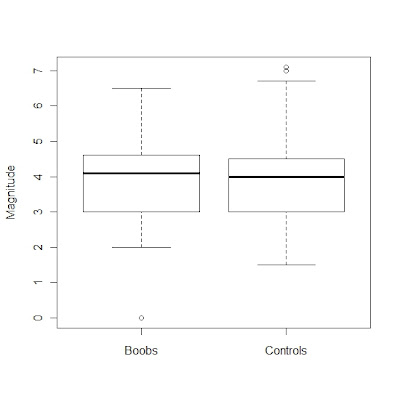Jen responds: No.
I know I said that I didn’t want to talk about Boobquake anymore, but I can’t help myself when data crunching is involved. Well, it’s also hard to ignore when dozens and dozens of people are tweeting at me asking if I’m wearing anything revealing. For the rest of my life I’m going to know when every major earthquake occurs via a very strange alert system.
But when a huge blog like Gawker decides to comment, I feel compelled to reply. Especially when they throw out all knowledge of statistics for the sake of giggling at boobs:
Remember when an Iranian cleric said earthquakes were God’s punishment for scantily-clad women, and then a bunch of scantily-clad women organized a naked protest to disprove the cleric, but then an earthquake actually occurred at the moment they bared their breasts? Well, there is a chance that today’s East Coast earthquake was a boobquake, too, because it’s National Go Topless Day, and there are all kinds of naked boobs in Central Park right now.
I already established that the earthquakes on Boobquake were not statistically significant – that is, they occurred at the same frequency and magnitude that you would expect at random chance. But one of the main criticisms of my “study” was that there was only one data point. I never realized I had National Go Topless Day to add to my data!
So, does bearing some boobage actually cause earthquakes?
Being the giant nerd I am, I’ve spent the last couple of hours looking up earthquake data at USGS, writing simple Python scripts, and plotting things in R. I’m pretty sure this isn’t how my graduate program envisioned me using the skills I’ve learned, but oh well.
I found the dates for the 2008, 2009, 2010, and 2011 National Go Topless Day. Today actually wasn’t National Go Topless Day – that was the 21st. New York was doing their own thing today, so I counted both the 21st and 23rd of days of decreased modesty. I downloaded the worldwide earthquake data for those 5 days plus boobquake, for a total of 6 samples. Now, we want to compare those especially lascivious days to “regular” days to see if earthquakes actually increase. For controls, I got the data for the three days before and the three days after any event. I picked neighboring days to control for any temporal changes that have nothing to do with boobs, but may reflect overall trends.
(As an aside, apparently National Go Topless Day is run by the Raelian cult. WTF? Allah may not support boobs, but aliens apparently do.)
Do boobs increase the number of earthquakes?

Nope (t test, p value = 0.65)
Do boobs increase the magnitude of earthquakes?

Nope (t test, p value = 0.26)
Sorry to disappoint all of you, but yet again, we have shown that boobs do not have the ability to manipulate plate tectonics. Alas, it seems this is another example confirmation bias – remembering the “hits” and ignoring the “misses.”
But if you’re still skeptical, I wasn’t bearing any cleavage when the earthquakes hit Colorado and Virginia today. Hmmm, though I was pantless. My butt isn’t anything to write home about, so many that’s why both of these earthquakes weren’t exactly devastating.
